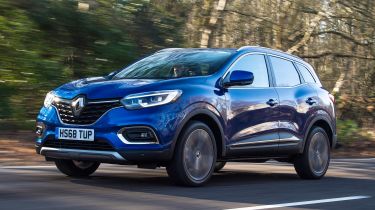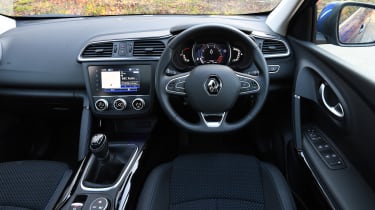Renault Kadjar (2015-2022) review - Engines, performance and drive
The Kadjar gets a range of powerful yet efficient turbocharged engines, but some rivals are more fun to drive
Not many people are likely to take the Renault Kadjar off-road, but while there are more rugged compact 4x4 options available, the Kadjar can still do a reasonable job away from the tarmac. This is especially true of the 1.7-litre diesel - it's the only model in the range offered with four-wheel drive, and its 50:50 differential lock function helps to boost traction when mud-plugging.
The Kadjar’s handling on the road isn’t the most involving, but it always feels secure and composed. Renault uses a system called Understeer Logic Control that applies the brakes to individual wheels to help the car hold its line through corners. However, the set-up doesn’t feel as natural as the XDS electronic differential fitted as standard to the SEAT Ateca, and there simply isn't as much grip. The steering offers little in the way of feel either, but it is light and precise, which makes the Kadjar easy to drive at parking speeds and around town.
Also on the plus side, the Kadjar scores strongly for refinement. Even though the 19-inch wheel and tyre combination delivers more road noise than you'll notice in a Peugeot 3008, the interior is well insulated from wind noise. The suspension does struggle with poorer surfaces, however, and the car fidgets and crashes around more than the Skoda Karoq.
0-62mph acceleration and top speed
The Renault Kadjar is available with four engines. The 1.3-litre TCe turbo petrol develops 138bhp, and can do 126mph and 0-62mph in 10.4 seconds - with maximum pulling power from just 1,600rpm. It's the best option in the engine lineup: it feels more than nippy enough on the open road, and for the most part it feels smooth - the exception being under very hard acceleration, where it starts to sound a little gruff.
It's good enough, in fact, that the more powerful unit won't really offer any benefits for anyone other than those who regularly intend to carry five people and a full boot. The extra 20bhp and 20Nm it offers are both delivered higher up the rev range, so in most situations it hardly feels any quicker than the lower-powered model. This is reflected in the performance figures: 0-62mph drops by only 0.5 seconds, and top speed increases by 4mph.
The 1.5-litre diesel option is better than ever. It makes 5bhp more than before (now 113bhp) and an overboost function means that there's a healthy extra dose of torque on offer when overtaking. Performance is only modest - 0-62mph takes 11.7 seconds - but the power delivery is smooth and refinement is excellent.
The 1.7-litre model is the ideal choice for drivers who wish to tow: it's the torquiest unit in the range, and the 148bhp output adds a more muscular shove when carrying heavy loads.






